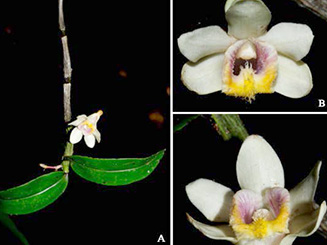On scientific requirements for presentation of "new records": the case of Dendrobium ruckeri (Orchidaceae)
DOI:
https://doi.org/10.20531/tfb.2019.47.2.05Keywords:
Conservation, Dendrobium chittimae, Dendrobium sect. Dendrobium, field guides, Flora of Thailand, herbarium vouchers, orchidsAbstract
How detailed and explicit should information presented in a “new record” account be to make the new record officially acceptable, and what kind of documentation is required? In recent years, this question has come to prominence, for example, due to the increasing rate with which new national taxon records are appearing in popular orchid field guides. The scientifically deficient publication of such “new records” precludes the alleged occurrences in Thailand from becoming formally accepted in the scientific literature – and the species in question from being considered for conservation in Thailand. To demonstrate the problem in detail, we present the case of Dendrobium ruckeri. First, we outline the historical introduction and occurrence of this species in the Thai botanical literature, and then provide a full taxonomic account, in effect demonstrating what we think a proper “new record” account should include. To avoid continued confusion over scientifically deficient new records, we urge non-professional botanists to properly document any new national record, supported by voucher specimens, and to publish their find in collaboration with appropriate professional botanists before including the newly discovered taxon in a field guide, or any other popular publication.
Downloads
References
Chayamarit, K., Chantaranothai, P., Middleton, D., Parnell, J., Simpson, D. & Wilkin, P. (2007). What constitutes a new taxon record for Thailand?. Thai Forest Bulletin (Botany) 35: 1–3.
Nanakorn, W. & Watthana, S. (2008). Queen Sirikit Botanic Garden (Thai native orchids 1). Wanida Press, Chiang Mai, 312 pp.
Pedersen, H.Æ., Kurzweil, H., Suddee, S. & Cribb, P.J. (2011). Orchidaceae 1 (Cypripedioideae, Orchidoideae, Vanilloideae). In: T. Santisuk & K. Larsen (eds), Flora of Thailand 12, pp. 1–302, Pls. I–XXIV. The Forest Herbarium, Department of National Parks, Wildlife and Plant Conservation, Bangkok.
Pedersen, H.Æ., Kurzweil, H., Suddee, S., de Vogel, E.F., Cribb, P.J., Chantanaorrapint, S., Watthana, S., Gale, S.W., Seelanan, T. & Suwanphakdee, C. (2014). Orchidaceae 2 (Epidendroideae p.p.: Neottieae, Tropidieae, Nervilieae, Gastrodieae, Thaieae, Calypsoeae, Arethuseae, Collabieae, Cymbidieae). In: T. Santisuk & H. Balslev (eds), Flora of Thailand 12, pp. 303–670, Pls. XXV–LVI. The Forest Herbarium, Department of National Parks, Wildlife and Plant Conservation, Bangkok.
Pedersen, H.Æ., Watthana, S. & Srimuang, K. (2009). Gunnar Seidenfaden and his heritage: developments in the diversity and organization of Thai orchid studies. Thai Forest Bulletin (Botany), special issue: 156–168.
Pooma, R. & Suddee, S. (eds) (2014). Tem Smitinand’s Thai Plant Names, revised edition 2014. The Office of the Forest Herbarium, Department of National Parks, Wildlife and Plant Conservation, Bangkok.
Schuiteman, A., Bonnet, P., Svengsuksa, B. & Barthélémy, D. (2008). An annotated checklist of the Orchidaceae of Laos. Nordic Journal of Botany 26: 257–316.
Seidenfaden, G. (1997). Contributions to the orchid flora of Thailand XIII. Olsen & Olsen, Fredensborg, 64 pp.
Sitthisajjadham, S. (2015). Orchid manual [in Thai]. Sarakadee Press, Bangkok, 272 pp.
Sitthisajjadham, S. & Kritsanachandee, N. (2002). Orchid guide book [in Thai]. Sarakadee Press, Bangkok, 248 pp.
Sitthisajjadham, S. & Tripetch, P. (2009). Wild orchids of Thailand 2 [in Thai]. Amarin Printing and Publishing Co., Bangkok, 463 pp.
Vaddhanaphuti, N. (2001). A field guide to the wild orchids of Thailand. 3rd ed. Silkworm Books, Chiang Mai, 216 pp.
________. (2005). A field guide to the wild orchids of Thailand. 4th ed. Silkworm Books, Chiang Mai, 272 pp.
Wood, H.P. (2006). The Dendrobiums. A.R.G. Gantner Verlag K.G., Ruggell, 847 pp.



